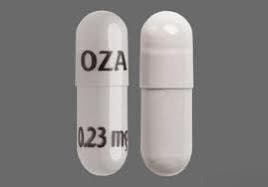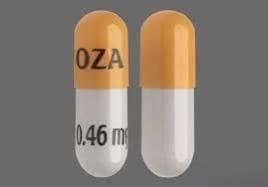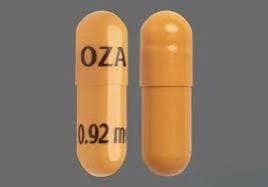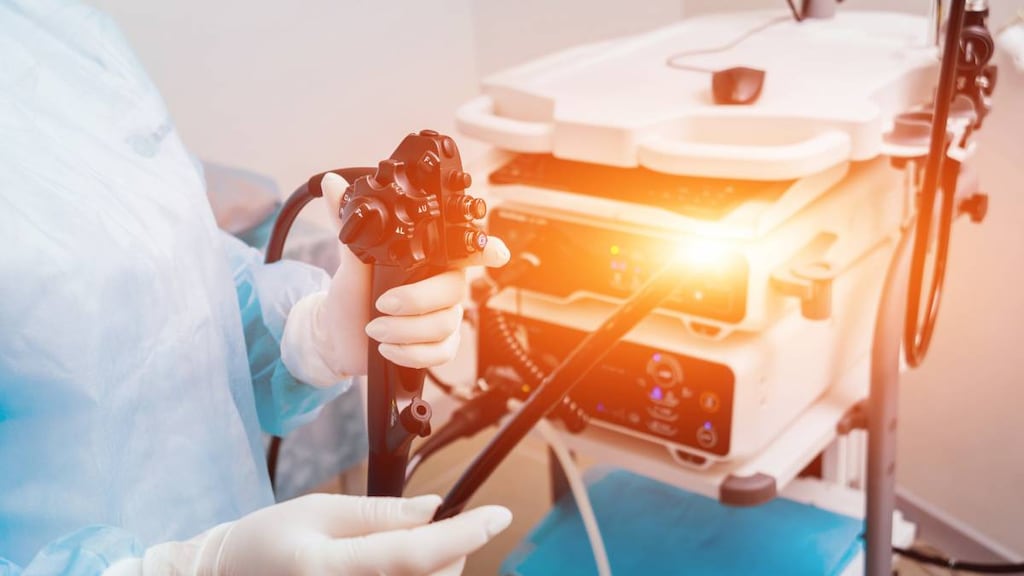What is Zeposia?
- Zeposia is a prescription medicine used to treat relapsing forms of multiple sclerosis (MS), to include clinically isolated syndrome, relapsing-remitting disease, and active secondary progressive disease, in adults.
- It is not known if Zeposia is safe and effective in children.
What is the most important information I should know about Zeposia?
Zeposia may cause serious side effects, including:
1. Infections. Zeposia can increase your risk of serious infections that can be life-threatening and cause death. Zeposia lowers the number of white blood cells (lymphocytes) in your blood. This will usually go back to normal within 3 months of stopping treatment. Your healthcare provider may do a blood test of your white blood cells before you start taking Zeposia.
Call your healthcare provider right away if you have any of the following symptoms of an infection during treatment with Zeposia and for 3 months after your last dose of Zeposia:
- fever
- feeling very tired
- flu-like symptoms
- cough
- painful and frequent urination (signs of a urinary tract infection)
- rash
- headache with fever, neck stiffness, sensitivity to light, nausea or confusion (these may be symptoms of meningitis, an infection of the lining around your brain and spine)
Your healthcare provider may delay starting or may stop your Zeposia treatment if you have an infection.
2. Slow heart rate (also known as bradyarrhythmia) when you start taking Zeposia. Zeposia may cause your heart rate to temporarily slow down, especially during the first 8 days that you take Zeposia. You will have a test to check the electrical activity of your heart called an electrocardiogram (ECG) before you take your first dose of Zeposia. Call your healthcare provider if you experience the following symptoms of slow heart rate:
- dizziness
- lightheadedness
- feeling like your heart is beating slowly or skipping beats
- shortness of breath
- confusion
- chest pain
- tiredness
Follow directions from your healthcare provider when starting Zeposia and when you miss a dose. See "How should I take Zeposia?".
See "What are possible side effects of Zeposia?" for more information about side effects.
Who should not take Zeposia?
Do not take Zeposia if you:
- have had a heart attack, chest pain (unstable angina), stroke or mini-stroke (transient ischemic attack or TIA), or certain types of heart failure in the last 6 months.
- have or have had a history of certain types of an irregular or abnormal heartbeat (arrhythmia) that is not corrected by a pacemaker.
- have untreated, severe breathing problems during your sleep (sleep apnea).
- take certain medicines called monoamine oxidase (MAO) inhibitors (e.g., selegiline, phenelzine, linezolid).
Talk to your healthcare provider before taking Zeposia if you have any of these conditions or do not know if you have any of these conditions.
What should I tell my healthcare provider before taking Zeposia?
Before taking Zeposia, tell your healthcare provider about all of your medical conditions, including if you:
- have a fever or infection, or you are unable to fight infections due to a disease or take or have taken medicines that lower your immune system.
- received a vaccine in the past 30 days or are scheduled to receive a vaccine. Zeposia may cause vaccines to be less effective.
- Before you start treatment with Zeposia, your healthcare provider may give you a chicken pox (Varicella Zoster Virus) vaccine if you have not had one before.
- have had chickenpox or have received the vaccine for chickenpox. Your healthcare provider may do a blood test for the chickenpox virus. You may need to get the full course of the vaccine for chickenpox and then wait 1 month before you start taking Zeposia.
- have a slow heart rate.
- have an irregular or abnormal heartbeat (arrhythmia).
- have a history of a stroke.
- have heart problems, including a heart attack or chest pain.
- have high blood pressure.
- have liver problems.
- have breathing problems, including during your sleep.
- have eye problems, especially an inflammation of the eye called uveitis.
- have diabetes.
- are pregnant or plan to become pregnant. Zeposia may harm your unborn baby. Talk with your healthcare provider if you are pregnant or plan to become pregnant. If you are a female who can become pregnant, you should use effective birth control during your treatment with Zeposia and for 3 months after you stop taking Zeposia. Talk with your healthcare provider about what birth control method is right for you during this time. Tell your healthcare provider right away if you become pregnant while taking Zeposia or if you become pregnant within 3 months after you stop taking Zeposia.
- are breastfeeding or plan to breastfeed. It is not known if Zeposia passes into your breast milk. Talk to your healthcare provider about the best way to feed your baby if you take Zeposia.
Tell your healthcare provider about all the medicines you take or have recently taken, including prescription and over-the-counter medicines, vitamins, and herbal supplements. Using Zeposia with other medicines can cause serious side effects. Especially tell your healthcare provider if you take or have taken:
- medicines that affect your immune system, such as alemtuzumab
- medicines to control your heart rhythm (antiarrhythmics), or heart beat
- strong CYP2C8 inhibitors such as gemfibrozil or clopidogrel
- medicines that inhibit breast cancer resistance protein transporters, such as cyclosporine and eltrombopag
- CYP2C8 inducers such as rifampin
- opioids (pain medicine)
- medicines to treat depression
- medicines to treat Parkinson's disease
You should not receive live vaccines during treatment with Zeposia, for at least 1 month before taking Zeposia and for 3 months after you stop taking Zeposia. Vaccines may not work as well when given during treatment with Zeposia.
Talk with your healthcare provider if you are not sure if you take any of these medicines.
Know the medicines you take. Keep a list of them to show your healthcare provider and pharmacist when you get a new medicine.
How should I take Zeposia?
You will receive a 7-day starter pack. You must start Zeposia by slowly increasing doses over the first week. Follow the dose schedule in the table below. This may reduce the risk of slowing of the heart rate.
| Days 1-4 | Take 0.23 mg (capsule in light grey color) 1 time a day |
| Days 5-7 | Take 0.46 mg (capsule in half-light grey and half-orange color) 1 time a day |
| Days 8 and thereafter | Take 0.92 mg (capsule in orange color) 1 time a day. |
- Take Zeposia exactly as your healthcare provider tells you to take it.
- Take Zeposia 1 time each day.
- Swallow Zeposia capsules whole.
- Take Zeposia with or without food.
- Avoid certain foods that are high (over 150 mg) in tyramine such as aged, fermented, cured, smoked and pickled foods. Eating these foods while taking Zeposia may increase your blood pressure.
- Do not stop taking Zeposia without talking with your healthcare provider first.
- Do not skip a dose.
- Start taking Zeposia with a 7-day starter pack.
- If you miss 1 or more days of your Zeposia dose during the first 14 days of treatment, talk to your healthcare provider. You will need to begin with another Zeposia 7-day starter pack.
- If you miss a dose of Zeposia after the first 14 days of treatment, take the next scheduled dose the following day.
What are the possible side effects of Zeposia?
Zeposia can cause serious side effects, including:
- See "What is the most important information I should know about Zeposia?"
- liver problems. Zeposia may cause liver problems. Your healthcare provider will do blood tests to check your liver before you start taking Zeposia. Call your healthcare provider right away if have any of the following symptoms:
- unexplained nausea
- vomiting
- stomach area (abdominal) pain
- tiredness
- loss of appetite
- yellowing of the whites of your eyes or skin
- dark colored urine
- increased blood pressure. Your healthcare provider should check your blood pressure during treatment with Zeposia. A sudden, severe increase in blood pressure (hypertensive crisis) can happen when you eat certain foods that contain high levels of tyramine. See "How should I take Zeposia?" section for more information.
- breathing problems. Some people who take Zeposia have shortness of breath. Call your healthcare provider right away if you have new or worsening breathing problems.
- a problem with your vision called macular edema. Your risk for macular edema is higher if you have diabetes or have had an inflammation of your eye called uveitis. Your healthcare provider should test your vision before you start taking Zeposia if you are at higher risk for macular edema or at any time you notice vision changes during treatment with Zeposia. Call your healthcare provider right away if you have any of the following symptoms:
- blurriness or shadows in the center of your vision
- sensitivity to light
- a blind spot in the center of your vision
- unusually colored vision
- swelling and narrowing of blood vessels in your brain. A condition called PRES (Posterior Reversible Encephalopathy Syndrome) is a rare condition that has happened with Zeposia and with drugs in the same class. Symptoms of PRES usually get better when you stop taking Zeposia. If left untreated, it may lead to a stroke. Your healthcare provider will do a test if you have any symptoms of PRES. Call your healthcare provider right away if you have any of the following symptoms:
- sudden severe headache
- sudden confusion
- sudden loss of vision or other changes in your vision
- seizure
- severe worsening of multiple sclerosis (MS) after stopping Zeposia. When Zeposia is stopped, symptoms of MS may return and become worse compared to before or during treatment. Always talk to your healthcare provider before you stop taking Zeposia for any reason. Tell your healthcare provider if you have worsening symptoms of MS after stopping Zeposia.
- allergic reactions. Call your healthcare provider if you have symptoms of an allergic reaction, including a rash, itchy hives, or swelling of the lips, tongue or face.
The most common side effects of Zeposia can include:
- upper respiratory tract infections
- elevated liver enzymes
- low blood pressure when you stand up (orthostatic hypotension)
- painful and frequent urination (signs of urinary tract infection)
- back pain
- high blood pressure
These are not all of the possible side effects of Zeposia. For more information, ask your healthcare provider or pharmacist. Call your healthcare provider for medical advice about side effects. You may report side effects to FDA at 1-800-FDA-1088.
Zeposia Images
General information about the safe and effective use of Zeposia
Medicines are sometimes prescribed for purposes other than those listed in a Medication Guide. Do not take Zeposia for conditions for which it was not prescribed. Do not give Zeposia to other people, even if they have the same symptoms you have. It may harm them. You can ask your healthcare provider or pharmacist for information about Zeposia that is written for health professionals.
How should I store Zeposia?
- Store Zeposia at room temperature between 68°F to 77°F (20°C to 25°C).
Keep Zeposia and all medicines out of the reach of children.
What are the ingredients in Zeposia?
Active ingredient: ozanimod
Inactive ingredients: colloidal silicon dioxide, croscarmellose sodium, magnesium stearate, and microcrystalline cellulose.
The capsule shell contains: black iron oxide, gelatin, red iron oxide, titanium dioxide, and yellow iron oxide.








